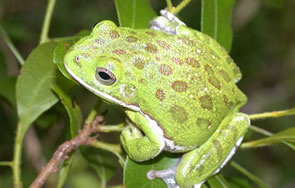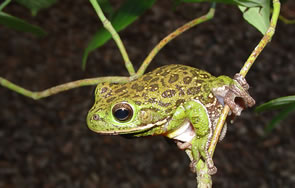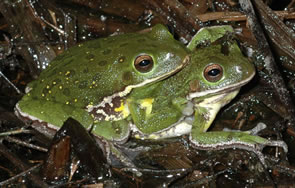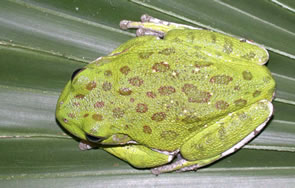
Barking Treefrog
Hyla gratiosa
Photo by JD Willson
Description: The barking treefrog is the largest treefrog species in North Carolina. It has large toe pads and is generally green with reddish-brown or purple spots. Like most treefrogs, the barking treefrog can change color rapidly, from green to gray or brown. It also has distinctly granular skin, which differentiates it from smooth-skinned species like the green treefrog.
Habitats and Habits: Barking treefrogs occur in the Coastal Plain and eastern Piedmont, primarily in pine forests and dry flatwoods. Although barking treefrogs can be found high in trees, they are also adept burrowers, sometimes taking refuge under sand or soil. They breed in permanent and semipermanent wetlands. Eggs are laid singly at the bottom of the pond. The tadpole period lasts about six to 10 weeks.
Call: Barking treefrogs call from April to September. Their breeding call is a single “toonk,” given every few seconds. From a distance, a breeding chorus may sound like a pack of barking dogs. Unlike other treefrogs that call from vegetation or the shoreline around a wetland, barking treefrogs call while floating on the surface.
Frog Fact: Although relatively common in North Carolina, barking treefrogs are uncommon and protected in Virginia, Delaware and Maryland.

The shaded region represents the range of the barking treefrog in North Carolina.



A pair of barking treefrogs in amplexus.
Photo
by Tom Luhring
The spots on the backs of barking treefrogs can fade under certain environmental conditions.
Photo by RW Van Devender


Photo by RW Van Devender
This website created by: Grant Connette and Evan Eskew.
For comments or questions contact M. Dorcas: midorcas@davidson.edu.
M. Dorcas homepage: http://bio.davidson.edu/dorcas
Davidson College, Davidson, North Carolina 28035-1719.
Text and maps from: Dorcas, M. E., S. J. Price, J. C Beane, and S. S. Cross. 2007. The Frogs and Toads of North Carolina. North Carolina Wildlife Resources Commission, Raleigh, NC. – Copyright by Michael E. Dorcas
Partial Funding for this website provided by a Associate Colleges of the South, National Science Foundation, and Duke Energy.
